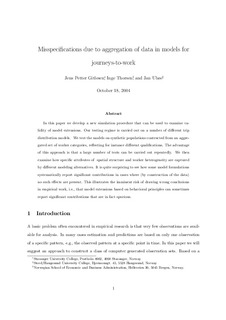| dc.contributor.author | Gitlesen, Jens Petter | |
| dc.contributor.author | Thorsen, Inge | |
| dc.contributor.author | Ubøe, Jan | |
| dc.date.accessioned | 2006-07-13T07:28:41Z | |
| dc.date.available | 2006-07-13T07:28:41Z | |
| dc.date.issued | 2004-10 | |
| dc.identifier.issn | 1500-4066 | |
| dc.identifier.uri | http://hdl.handle.net/11250/163687 | |
| dc.description.abstract | In this paper we develop a new simulation procedure that can be used to examine validity of model extensions. Our testing regime is carried out on a number of different trip distribution models. We test the models on synthetic populations contructed from an aggregated set of worker categories, reflecting for instance different qualifications. The advantage of this approach is that a large number of tests can be carried out repeatedly. We then examine how specific attributes of spatial structure and worker heterogeneity are captured by different modeling alternatives. It is quite surpricing to see how some model formulations systematically report significant contributions in cases where (by construction of the data) no such effects are present. This illustrates the imminent risk of drawing wrong conclusions in empirical work, i.e., that model extensions based on behavioral principles can sometimes report significant contributions that are in fact spurious. | en |
| dc.format.extent | 241979 bytes | |
| dc.format.mimetype | application/pdf | |
| dc.language.iso | eng | en |
| dc.publisher | Norwegian School of Economics and Business Administration. Department of Finance and Management Science | en |
| dc.relation.ispartofseries | Discussion paper | en |
| dc.relation.ispartofseries | 2004:13 | en |
| dc.title | Misspecifications due to aggregation of data in models for journeys-to-work | en |
| dc.type | Working paper | en |
